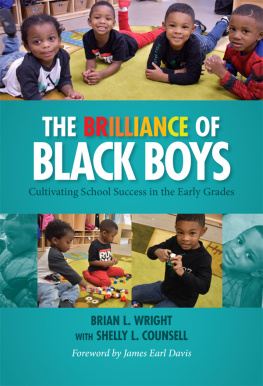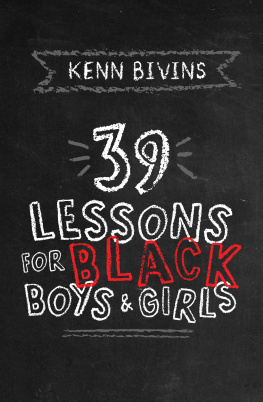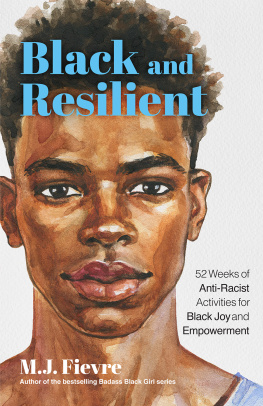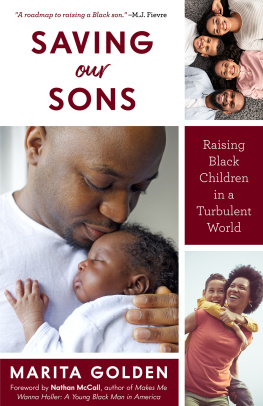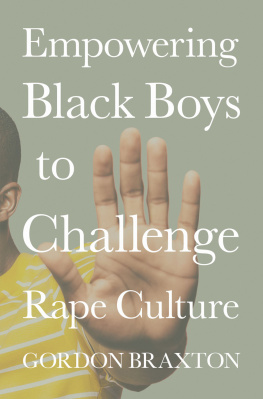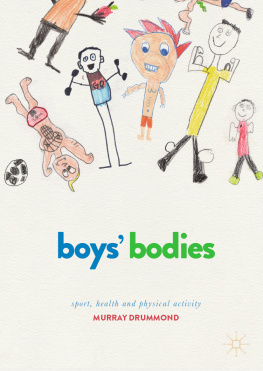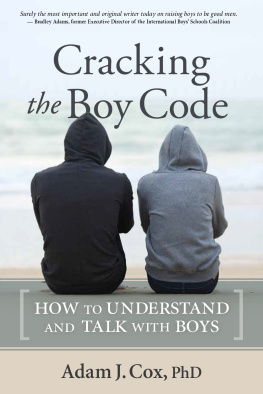T HE B RILLIANCE OF B LACK B OYS
C ULTIVATING S CHOOL S UCCESS IN THE E ARLY G RADES
B RIAN L. W RIGHT
WITH S HELLY L. C OUNSELL
Foreword by James Earl Davis

Published by Teachers College Press, 1234 Amsterdam Avenue, New York, NY 10027
Copyright 2018 by Teachers College, Columbia University
Cover design by Holly Grundon Design. Cover photo of local Memphis schoolchildren courtesy of Porter-Leath.
.
contains a figure from Anti-Bias Education for Young Children and Ourselves, by L. Derman-Sparks & J. Olsen Edwards, 2010, Washington, DC. NAEYC. Copyright 2010 NAEYC. Reprinted with permission.
All rights reserved. No part of this publication may be reproduced or transmitted in any form or by any means, electronic or mechanical, including photocopy, or any information storage and retrieval system, without permission from the publisher. For reprint permission and other subsidiary rights requests, please contact Teachers College Press, Rights Dept.:
Library of Congress Cataloging-in-Publication Data
Names: Wright, Brian L., author. | Counsell, Shelly, author.
Title: The brilliance of Black boys : cultivating school success in the early grades / Brian L. Wright with Shelly Counsell.
Description: New York, NY : Teachers College Press, [2018] | Includes bibliographical references and index.
Identifiers: LCCN 2017053028 (print) | LCCN 2018005220 (ebook) | ISBN 9780807776810 (ebook) | ISBN 9780807758922 (pbk. : alk. paper)
Subjects: LCSH: African AmericansEducation (Early childhood) | African American boysEducationSocial aspects.
Classification: LCC LC2765 (ebook) | LCC LC2765 .W75 2018 (print) | DDC 371.829/96073dc23
LC record available at https://lccn.loc.gov/2017053028
ISBN 978-0-8077-5892-2 (paper)
ISBN 978-0-8077-7681-0 (ebook)
Foreword
There is something beautiful about Black boys. As children, they play in innocence, whisper in imagination, and sing in colors of joy. Yet historical and contemporary accounts of Black boys in schools too often mask the sublime with pejorative narratives of deficit and danger. We know so little of these boys early academic dispositions because stereotypes and misinformation hide their realities. Educators, researchers, and policy leaders are implicated in dimming the sparkle of Black boys potential and possibility, as well as in shaping how the public understands them. For instance, images and discourses that construct Black boys as problems distort their actual in- and out-of-school lives. While these problem-making mechanisms are generally external to Black boys, their consequences become the burdens these boys face in school and society. However, early childhood education (PK3rd grade) as a field of practice, research, and policy does not have to be limited by frameworks and expectations that diminish the radiance of these children. The Brilliance of Black Boys: Cultivating School Success in the Early Grades claims new ground to advance knowledge and practice that can change the narrative about Black boys and their early schooling. With this purpose in mind, Brian L. Wright and Shelly L. Counsell offer a book that challenges and outlines a path of transformation for how schools and the broader society think about, engage with, and foster success for Black boys.
The growing expansion of social science research focusing on Black boys brings needed attention to this population. New scholarship that moves away from stereotypical problem-based themes and toward broader conceptions and considerations of Black boys is duly necessary. The Brilliance of Black Boys expands our knowing of Black boys and in turn holds schools and educators accountable for responding to these new understandings. For instance, the increasing use of narratives questioning stale assumptions of academic engagement and growth enliven scholarship that has for too long succumbed to traditional notions about school readiness and social competencies of these young learners. Drawing on empirical evidence and best practices, The Brilliance of Black Boys should make many uncomfortable and motivate others to do better.
Another important contribution of The Brilliance of Black Boys is the advancement of anti-deficit thinking about Black boys and asset-based approaches to research and practice. The authors achievement framework helps in changing the narrative and challenging research on Black boys, especially in discussions about school readiness. To be honest, I have been waiting for this book. My anticipation was not based on the complete absence of approaches that emphasize strengths and assets in educations; a number of scholars engage in this kind of work across the education pipeline with a variety of student groups. However, my excitement about this book comes from its audacity to assert a perspective about the early education of Black boys that centers their cultural authenticity inclusive of identity, agency, and lived experiences. This is an ambitious undertaking, but early childhood education desperately needs it to enact its broader goals of igniting intellectual curiosity, cultivating social competencies, and supporting the sociocultural development of all children.
The Brilliance of Black Boys fills both important scholarly and practice gaps in discerning boys experience in early childhood education at the intersection of race and gender. Not limited to challenging the conventional constructions and stereotypes of Black boys, the book additionally serves as a barometer and guide for how schools reconsider whom these students are, with attention to their prior knowledge and experience. For sure, the role of early childhood education is so consequential in the development of Black boys and in how they begin to see themselves and their contributions in the world. While difficult to imagine, the potential social casualties of doing this improperly could haunt us for generations. Thus, the risk is too great for continuing to denying Black boys access to appropriate and sustaining early learning opportunities.
Explaining how to build a culture of success for Black boys is a central objective of The Brilliance of Black Boys . By introducing a conceptual frame to improve the success of Black boys, Wright and Counsell argue for classrooms and curricula integration of cultural markers, identity exploration and the lived experiences of Black boys. Notably, the authors posit a cultural responsiveness and competence in teaching Black boysone that considers unique racial-gender awareness and promotes congruent learning strategies, such as using more mirror books rather than window books and revisiting questions about who counts as a good student. This unapologetic call for centering the social, cultural, and language practices of Black boys is a core contribution of this book, but its implications go beyond the role of teachers, curricula, and school culture. The effect of recognizing and honoring the authenticity of Black boys holds the possibility of reorienting early childhood education to become more inclusive and meaningful. Placing Black boys at the center of understanding who they are, and what and how they learn in early education, affords opportunities for genuine discovery and development.
Creating these nurturing early education environments of self-discovery and social awareness, where Black boys can imagine, learn, love, and grow is critical, given the constraints that society and educational institutions will impose. Based on this timely text, I am encouraged that early education can be intentional in its objective to acknowledge and affirm the lives of Black boys. I am also convinced that early childhood educators and the culture of schools can serve Black boys effectively. As a result, we can begin to actualize early schooling as a site for the effective development of social identities and competencies of Black boysaligned with who they are and their possible selves.

